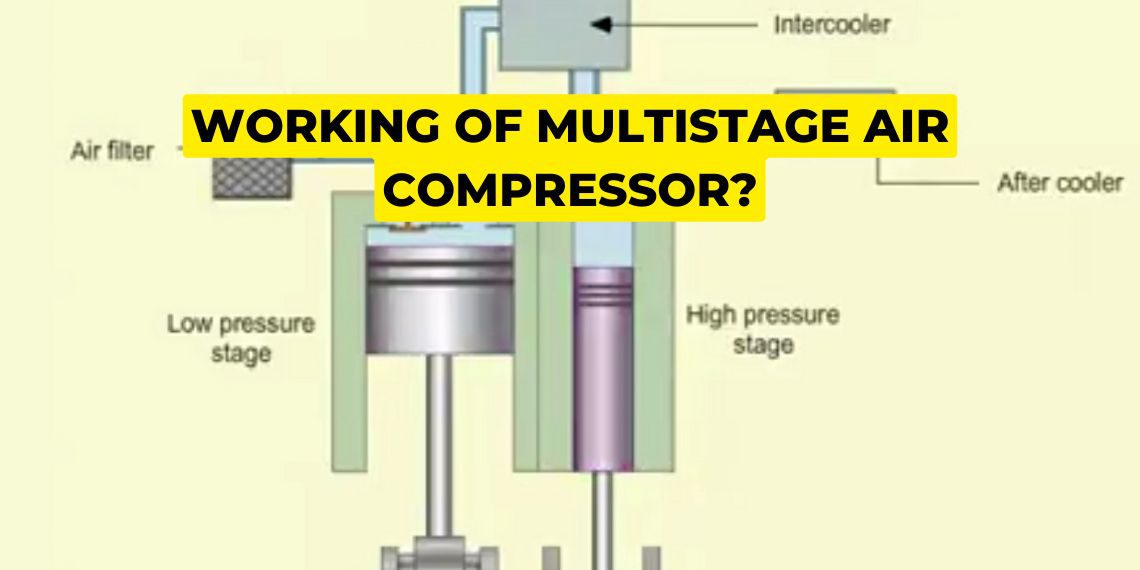What is multistage air compressor? | Why we need two stage air compressor on ship? | Working of multistage air compressor?
A multistage air compressor is a type of air compressor that uses multiple stages of compression to achieve high pressures. Each compression stage consists of a set of cylinders, with each cylinder increasing the pressure of the air before it is passed on to the next stage. In a multi-stage compressor, the first stage typically compresses the air to an intermediate pressure, which is then passed to a second stage that further compresses the air to the desired final pressure. Some multi-stage compressors may have three or more stages, depending on the required output pressure.

One advantage of multi-stage compressors is that they can achieve higher pressures than single-stage compressors while using less energy since the compression is divided over multiple stages. However, they can be more complex and expensive to operate and maintain than single-stage compressors.
Why do we need a multistage air compressor on a ship?
A two-stage air compressor is commonly used on ships for several reasons. Firstly, a two-stage compressor can achieve higher pressures than a single-stage compressor. This is because the compressed air is partially cooled between stages, which reduces its volume and allows for further compression.
Secondly, a two-stage compressor can operate more efficiently than a single-stage compressor. By compressing the air in two stages, the compressor is able to use less energy to achieve the desired pressure, as compared to a single-stage compressor which would have to work much harder to achieve the same pressure. This means the compressor is doing less work to achieve this pressure and increase our compressor efficiency. See in this graph.

Higher pressure requirements: (30- 35 bar) Used in some applications on board a ship, such as starting/cranking large diesel engines, require air at very high pressures.
Working of Multistage air compressor
On ships, compressed air is crucial for various applications, typically produced at high pressures (around 30-35 bar). The compression process involves two stages. In the first stage, air is drawn in at atmospheric pressure, where the molecules are loosely packed, limiting the achievable pressure. Following the initial compression, the compressed air passes through an intercooler to mitigate heat and reduce its volume.
Upon exiting the intercooler, the second stage begins, involving a smaller cylinder than the first. Here, the suctioned air undergoes further compression, reaching very high pressures and elevating its temperature. Post-compression, the air proceeds through a delivery port into an aftercooler, serving to cool the air and decrease its volume. Finally, the compressed air is stored in an air bottle, ready for use in various shipboard applications. This multistage process ensures the production of high-pressure compressed air while managing temperature and volume considerations through intercooling and aftercooling stages.

Note:
If you want to learn more about this topic, we suggest checking out our Combo package with the given link https://www.merchantnavydecoded.com/courses/c/ . It’s a great way to dive deeper into the subject through video explanations. This package covers all the important details and presents them in an easy-to-understand format. Watching the videos will help you grasp the topic better and make learning more enjoyable. So, we highly recommend giving our Combo package a try to enhance your knowledge on the subject.
Disclaimer :- The opinions expressed in this article belong solely to the author and may not necessarily reflect those of Merchant Navy Decoded. We cannot guarantee the accuracy of the information provided and disclaim any responsibility for it. Data and visuals used are sourced from publicly available information and may not be authenticated by any regulatory body. Reviews and comments appearing on our blogs represent the opinions of individuals and do not necessarily reflect the views of Merchant Navy Decoded. We are not responsible for any loss or damage resulting from reliance on these reviews or comments.
Reproduction, copying, sharing, or use of the article or images in any form is strictly prohibited without prior permission from both the author and Merchant Navy Decoded.



